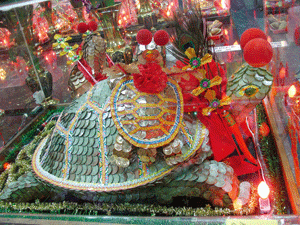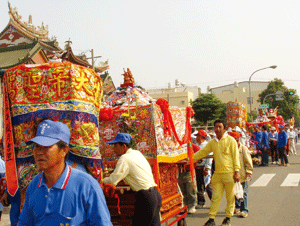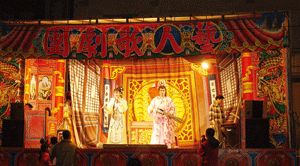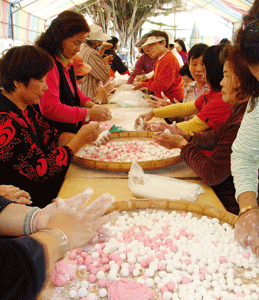Houjin Gan Wei Festival The various celebrations of Kaohsiung's Chinese New Year and Lantern Festival / 探訪高雄的傳統面貌 探訪高雄的傳統面貌
Houjin Gan Wei Festival
The various celebrations of Kaohsiung's Chinese New Year and Lantern Festival
 ◎Text by Hsin-Yi Peng
◎Text by Hsin-Yi Peng
◎Photos by Sheng-Tong Lin
Chinese Lunar New Year is the most significant holiday in Chinese society. Celebrations begin on New Year's Eve and continue until the 15th of January of the lunar calendar. The Lantern Festival, begins on the last day of the New Year's celebration. The Kaohsiung Lantern Festival is a street fair, during which artistic lanterns are on display. Every year, people go to admire the hand made lanterns. People also carry hand-held lanterns.
Kaohsiung also celebrates the "Houjin Gan Wei Festival" . This is a festival that is celebrated locally and gives visitors special insight into Kaohsiung's culture. Sheng-yun and Feng-ping Temples, with the help of three other temples, have hosted the Houjin Gan Wei Festival for many years. Historically, the region was mostly agricultural. During Chinese New Year, the temples would organize holiday markets for locals who were taking a break from their farm work. During the festivities residents would buy and exchange products. As the years went by the markets gradually grew and evolved into today's large Houjin Gan Wei Festival. The Houjin Gan Wei festivital is deeply rooted in folklore and local religious practices. The modern Houjin Gan Wei Festival begins shortly before New Year's Eve.
At the end of December 2008 of the lunar calendar, several famous calligraphers were invited to participate in the warm up activities. The calligraphers even gave away a New Year's couplet.
 There are a number of Taoist celebrations that occur during the New Year's celebrations. On December 24th of the lunar calendar, feasts are held to honor Tai Sui. This Taoist God is believed to be the guardian of the home. Taoists believe on December 24th Tai Sui returns to heaven to report on the year's activities. Taoists hold banquets in his honor, with the hopes he will deliver a positive report to Yu Huang (Jade Emperor of Heaven).
There are a number of Taoist celebrations that occur during the New Year's celebrations. On December 24th of the lunar calendar, feasts are held to honor Tai Sui. This Taoist God is believed to be the guardian of the home. Taoists believe on December 24th Tai Sui returns to heaven to report on the year's activities. Taoists hold banquets in his honor, with the hopes he will deliver a positive report to Yu Huang (Jade Emperor of Heaven).
Another big celebration occurs on January 9th of the lunar calendar. This is the Jade Emperor's birthday and celebrations are held at the Feng-ping Temple. These celebrations begin at midnight and continue throughout the next day.
At the end of Chinese New Year the temples in the Houjin District also hold the Prosperity Salutations Parade. The deities residing in the temples are taken on a tour to bring blessings and prosperity to the local residents. The route covers all five subdivisions.
The Turtle Granting Contest marks the climax of the Houjin Gan Wei Festival. This occurs on Lantern festival and is a very historic practice. Temples host a contest in which participants throw a pair of crescent-shaped pieces of wood. According to Taoism the gods are responding when the flat side of one of the crescent-shaped wood pieces is facing up and the flat side is facing down on the other. These are known as "holy cups". The person who gets the most "holy cups" wins the contest. The prize is a "Prosperity Turtle". It is believed the winner of the turtle will be granted prosperity and good fortune by the gods. The turtle-shaped deity is made of a variety of materials. It is usually constructed from rice and flour, but sometimes they are constructed of pure gold. The winner is then expected to donate twice the worth of the turtle over the next year. This gesture is symbolic of the winner's generosity and sharing of their good fortune. This would also give others the opportunity to be granted the turtle's good fortune.
On January 18th of the lunar calendar, a grand parade is held to honor the lucky winner of the Turtle Granting Contest. During the parade the turtle is escorted to the winner's house. The parade marks the end of the Houjin Gan Wei Festival. The entire Gan Wei Festival is a month-long affair and includes many other festive activities. It also exemplifies the unique way Kaohsiung residents celebrate the New Year.
探訪高雄的傳統面貌
熱鬧的「後勁甘尾會」
◎文/林昀熹
◎攝影/林勝童
 農曆春節在華人社會中是年度最大的節慶,熱鬧的氣氛會從除夕一直延續到元宵節,而元宵節時除了參觀盛大的高雄燈會、猜燈謎、提燈籠遊街,如果還想要感受更傳統、更不一樣的氣氛,不妨到北高雄後勁地區「後勁甘尾會」走一遭,沾染歡樂的年節氣息,也看到高雄傳統而在地的另一面。
農曆春節在華人社會中是年度最大的節慶,熱鬧的氣氛會從除夕一直延續到元宵節,而元宵節時除了參觀盛大的高雄燈會、猜燈謎、提燈籠遊街,如果還想要感受更傳統、更不一樣的氣氛,不妨到北高雄後勁地區「後勁甘尾會」走一遭,沾染歡樂的年節氣息,也看到高雄傳統而在地的另一面。
「後勁甘尾會」是由後勁地區聖雲宮、鳳屏宮等五座廟宇共同主辦。早期農業社會時代,過年期間、農忙告一段落後,廟埕往往會舉辦市集,讓大家交換或購買一些商品,而「後勁甘尾會」也就是由這樣的市集演變而來。
「後勁甘尾會」的活動結合民間信仰,從農曆過年前就熱鬧展開。以2009年來說,農曆12月底就邀請書法名家揮毫贈送春聯,炒熱年節氣氛;農曆12月24日的「謝太歲」,便是民間信仰中的送神儀式,此儀式主要目的是全年看守家中的神明要在這天返回天庭述職,因此要好好款待祂、請祂在玉皇大帝面前幫忙說好話;農曆1月9日則是玉皇大帝生日,因此從1月8日半夜開始,鳳屏宮廣場就有盛大的「謝天公」儀式。
 在送神、謝天公之後,「平安遶境」是甘尾會的第一波高潮,這天廟宇中的神明會「出巡」,在後勁五個里中挨家挨戶巡訪,為地方上的百姓帶來一整年的平安與祝福;而元宵節前後共三天的「乞龜」,更是眾所期待的盛事。
在送神、謝天公之後,「平安遶境」是甘尾會的第一波高潮,這天廟宇中的神明會「出巡」,在後勁五個里中挨家挨戶巡訪,為地方上的百姓帶來一整年的平安與祝福;而元宵節前後共三天的「乞龜」,更是眾所期待的盛事。
「乞龜」是一項流傳久遠的民間習俗,在乞龜這幾天間,擲筊(駁杯)獲得最多連續「聖杯」(聖杯落地後,一個面朝上,另一個弧面朝上,也就是神明表示同意者,就可以把「平安龜」迎回家,藉此祈求全年平安、賺大錢;而乞得平安龜的人,來年要奉獻加倍的「平安龜」(以米、糕餅,甚至黃金等各種材質都有),讓其他民眾「乞龜」,把好運轉給他人。
而今年乞得平安龜的人,在1月18日那天以盛大的遊行,將平安龜迎回家供奉,為「後勁甘尾會」畫下歡樂句點。除了這些民俗之外,甘尾會活動舉辦近一個月,在熱鬧的氛圍中展現台灣特有的民俗風情。